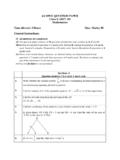Transcription of SUPPORT MATERIAL FOR BIOLOGY CLASS XI
1 [ 1 ] SUPPORT MATERIAL FOR BIOLOGYCLASS XIList of members who prepared SUPPORT materialTEAM MEMBERSS. and S. D. SharmaPrincipal9868341155 Rajkiya Pratibha Vikas VidyalayaRaj Niwas Marg, Ranveer SinghLecturer (Bio)9891069977 Sarvodaya Bal VidyalayaTimarpur, R. P. SinghLecturer (Bio)9990081661 Rajkiya Pratibha Vikas VidyalayaKishan Ganj, Sarita SinghLecturer (Bio)Rajkiya Pratibha Vikas VidyalayaShalimar Bagh, V. S. MalikLecturer (Bio)9868162341 Rajkiya Pratibha Vikas VidyalayaCivil Lines, Reetesh GuptaLecturer (Bio)9811690031 Rajkiya Pratibha Vikas VidyalayaSurajmal Vihar, Delhi-92.[ 2 ]Chapter-1 THE LIVING WORLDPOINTS TO REMEMBERC haracteristics of Living Organisms : Growth, reproduction, metabolism,cellular organisation, consciousness (ability to sense environment), self-rep-licating and self regulation.
2 Reproduction and growth are NOT defining properties. Metabolism, cellular organisation and consciousness are : Term used to refer to the number of varieties of plant andanimals on for classification : To organise the vast number of plants and animalsinto categories that could be named, remembered, studied and for Nomenclature : Latinised names are used. First word is genus, second word is species name. Printed in italics; if handwritten then underline separately. First word starts with capital letter while species name written in small : International Code of Botanical Nomenclature (for giving scientificname to plants.)
3 ICZN : International Code of Zoological Nomenclature (for givingscientific name to animals.)Taxonomy : Study of principles and procedures of Nomenclature : Given by Carolus Linnaeus. Each scientific namehas two components - Generic name + Specific : It deals with classification of organisms based on theirdiversities and relationships among them. Term was proposed by CarlousLinnaeus who wrote Systema Naturae .Taxonomic Hierarchy : Arrangement of various steps (categories or taxaor ranks) of classification.[ 3 ]Species Genus Family Order CLASS Phylum (for animals) /Division (for plants) Kingdom Species : All the members that can interbreed among themselves and canproduce fertile offsprings are the members of same species.
4 This is the bio-logical concept of species proposed by Domains of Life : Proposed by Carl Woese in 1990 who also pro-posed the six kingdom classification for living organisms. The three Do-mains are Archaea, Bacteria and ArchaebacteriaDomainsEubacteria MoneraEukaryota Protista Mycota Plantae AnimaliaHerbarium Storehouse of dried, pressed and preserved plant specimenon Garden Collection of living plants for aids Zoological Park (Places where wild animals are kept in pro-tected environment.) Keys (Used for identification of plant and animals on the basis ofsimilarities and dissimilarities.)
5 Flora (Index to plant species found in a particular area.) Manuals (Provide information for identification of name of species in anarea.) Monograph (Contain information on one taxon.)QUESTIONSVery Short Answer Questions (1 mark each)1. Define What is systematics ?3. Give the names of two famous botanical Answer Questions-II (2 marks each)4. What is the basis of modern taxonomical studies ?[ 4 ] growth and reproduction cannot be taken as defining property ofall living organisms ?6. How is a taxon (pl. taxa) defined ?Short Answer Questions-I (3 marks each) is the difference between Botanical Garden and Herbarium ?
6 Are analytical in nature and are helpful in identification and clas-sification of ?9. Define : (a) Genus(b) Family(c) OrderLong Answer Questions (5 marks each)10. What are the universal rules of nomenclature ? What does Linn. refer to inMangifera indica Linn. ?11. Illustrate taxonomical hierarchy with suitable examples from plant and ani-mal Short Answers (1 mark each) that can interbreed to produce fertile arrangement which also takes into account evolutionary rela-tionships between (England) and National Botanical Research Institute (Lucknow), In-dian Botanical Garden (Howrah).Short Answers-II (2 marks each) and internal structure, structure of cell, development process andecological Non-living things can also increase in mass by accumulation of materialon surface.
7 Many organisms do not reproduce ( , mules, sterile worker bees). category in a taxonomical hierarchy represents a rank and is calledtaxon.[ 5 ]Short Answers-I (3 marks each) Garden : Collection of living : Collection of dried, pressed and preserved plant specimens page no. 13 NCERT, Text Book of BIOLOGY for CLASS : Group of related species; Family : Group of related genera; Order :Group of related Answers (5 marks) page no. 7, NCERT, Text Book of BIOLOGY for CLASS XI. Linn. indicates that the species was first described by table , page no. 11, NCERT, Text Book of BIOLOGY for CLASS XI.[ 6 ]Chapter-2 BIOLOGICAL CLASSIFICATIONPOINTS TO REMEMBERSYSTEMS OF Earliest Classification was given by plants into herbs, shrubs and into those with RBC s and those who donot have it.
8 Two kingdom classification : Given by CarolousLinnaeus Plant kingdom and Animal kingdom. Five kingdom classification : By R. Monera, Protista, Fungi, Plantae andAnimalia are the five Monera : Has bacteria a sole member. Bacteria can have shapes like : Coccus (spherical), Bacillus (rod-shaped), Vibrio (commashaped) and sprillum (spiral shaped). Bacteria found almost everywhere and can bePhotosynthetic autotrophs, Chemosynthetic autotrophs or : Halophiles (salt-loving) Thermoacidophiles (in hot springs)Bacteria Methanogens (in marsh and in gut ofruminant animals. Produce methane gas.)
9 Eubacteria : Photosynthetic autotrophs likeCyanobacteria. Somelike Anabaena havespecialised cells called heterocysts fornitrogen fixation. Chemosynthetic autotrophs : Oxidisevarious inorganic substances likenitrates/nitrites, ammonia and use releasedenergy for their ATP production.[ 7 ] Heterotrophic bacteria : Decomposes,help in making curd, production of antibiotics, N2 fixation, cause diseases like cholera, : Completely lack cell wall. Smallest living cells. Can survive without oxygen. Pathogenic in animals and Prostita(All single celled eukaryotes) Forms a link between plants, animals and fungi.
10 (i) Chrysophytes (Has diatoms and golden algae) Cell walls have silica and cell walls overlap to fit together like a soap box. Their accumulation forms Diatomaceous Earth . Used in polishing, filtration of oils and syrups.(ii) Dinoflagellates : Marine, photosynthetic, cell wall has cellulose. Two flagella one longitudinal and other transversely in a furrow betweenwall plates.(iii)Euglenoids : Have protein rich layer pellicle which makes body flexible. Photosynthetic in presence of sunlight but become heterotrophs if they donot get sunlight.(iv)Slime Moulds : Saprophytic protists Form aggregates to form plasmodium grows on decaying twigs and leaves.









